Body length: 35–64 mm.
Eyes: eye interommatidial setaeseta:
a sclerotized hair-like projection of the cuticle
present, eye deeply emarginateemarginate:
notched at the margin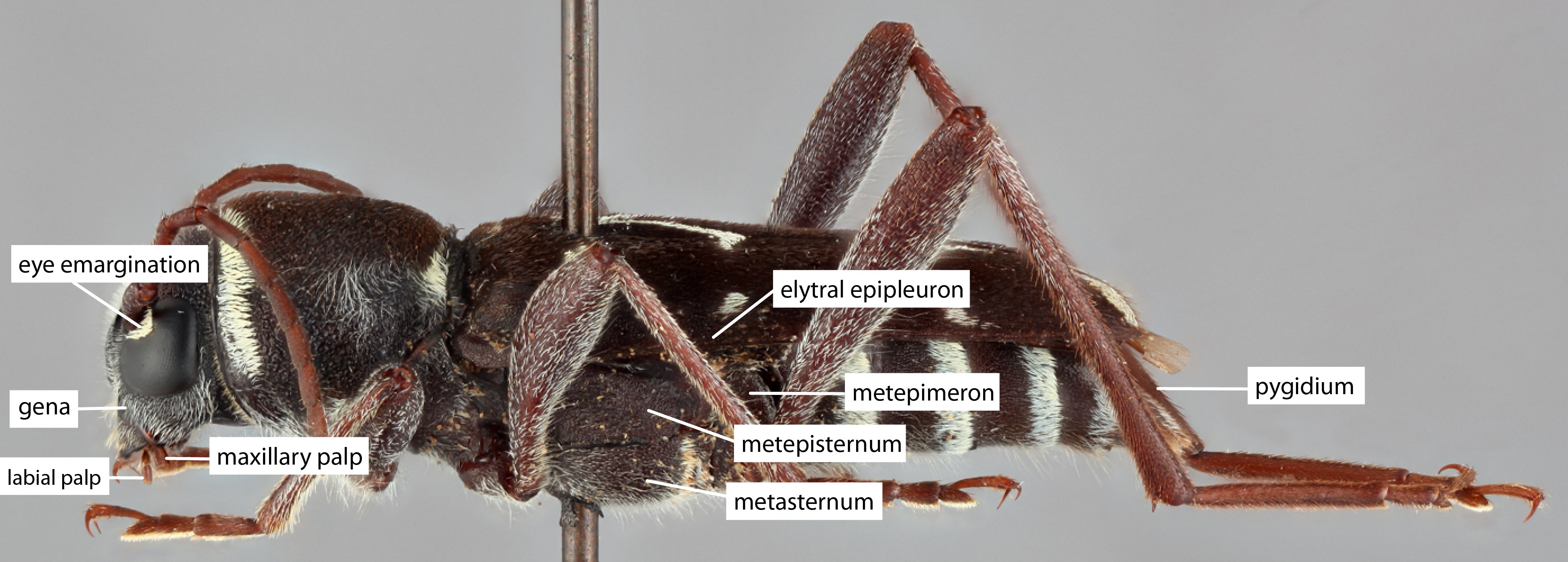 > half width, eye ommatidial density coarse or fine.
> half width, eye ommatidial density coarse or fine.
Antennaeantenna:
in larval and adult insects, paired segmented appendages, borne one on each side of the head, functioning as sense organs and bearing a large number of sensilla
: antennal length reaches between basebase:
the part of any appendage or structure that is nearest the body
and end of elytraelytron:
the leathery forewing of beetles, serving as a covering for the hind wings, commonly meeting opposite elytron in a straight line down the middle of the dorsum in repose
or reaching/surpassing end of body, antennal flagellar segments elongateelongate:
much longer than wide
, scapescape:
the first proximal segment of the antenna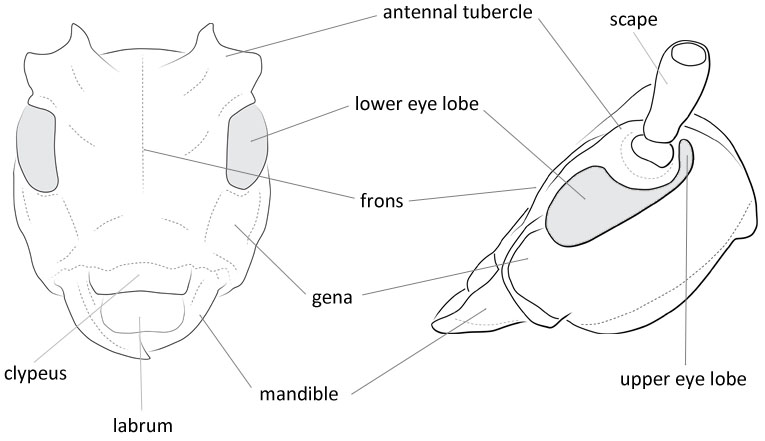 smooth/punctate at apexapex:
smooth/punctate at apexapex:
end of any structure distad to the base
or cicatrixcicatrix:
a scar; a scar-like structure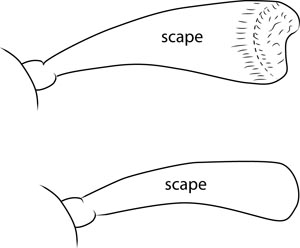 (scar) at apexapex:
(scar) at apexapex:
end of any structure distad to the base
, antennal segment 3 > scapescape:
the first proximal segment of the antenna .
.
Pronotumpronotum:
the upper and dorsal part of the prothorax
: pronotumpronotum:
the upper and dorsal part of the prothorax
shape transversetransverse:
broader than long
, pronotumpronotum:
the upper and dorsal part of the prothorax
lateral armature absent.
Prosternum: prosternal processprosternal process:
a posterior extension of the prosternum between the coxae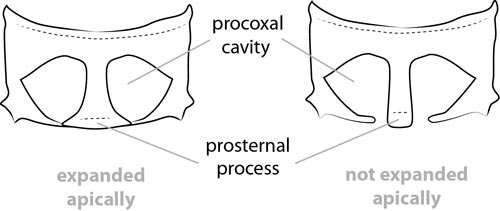 dilated at apexapex:
dilated at apexapex:
end of any structure distad to the base
, procoxal cavities open posteriorly.
Elytraelytron:
the leathery forewing of beetles, serving as a covering for the hind wings, commonly meeting opposite elytron in a straight line down the middle of the dorsum in repose
: elytral length reaching or close to end of abdomen, elytral apicesapex:
end of any structure distad to the base
with tooth or spinespine:
a protuberance with an acute (sharp) distal end
, elytral color black, brown, metallic, or yellow, elytral color pattern absent.
Legs: visible tarsomerestarsomere:
subdivision or article of the tarsus, usually numbering from two to five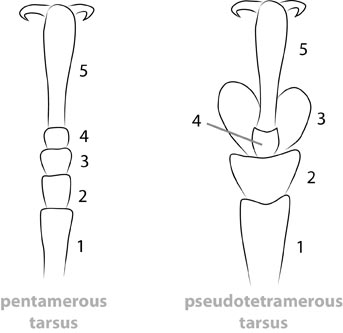 : 4, femora slender, protibial spursprotibial spur:
: 4, femora slender, protibial spursprotibial spur:
sclerotized spine(s) located at the distal tibia; can be single, double, or absent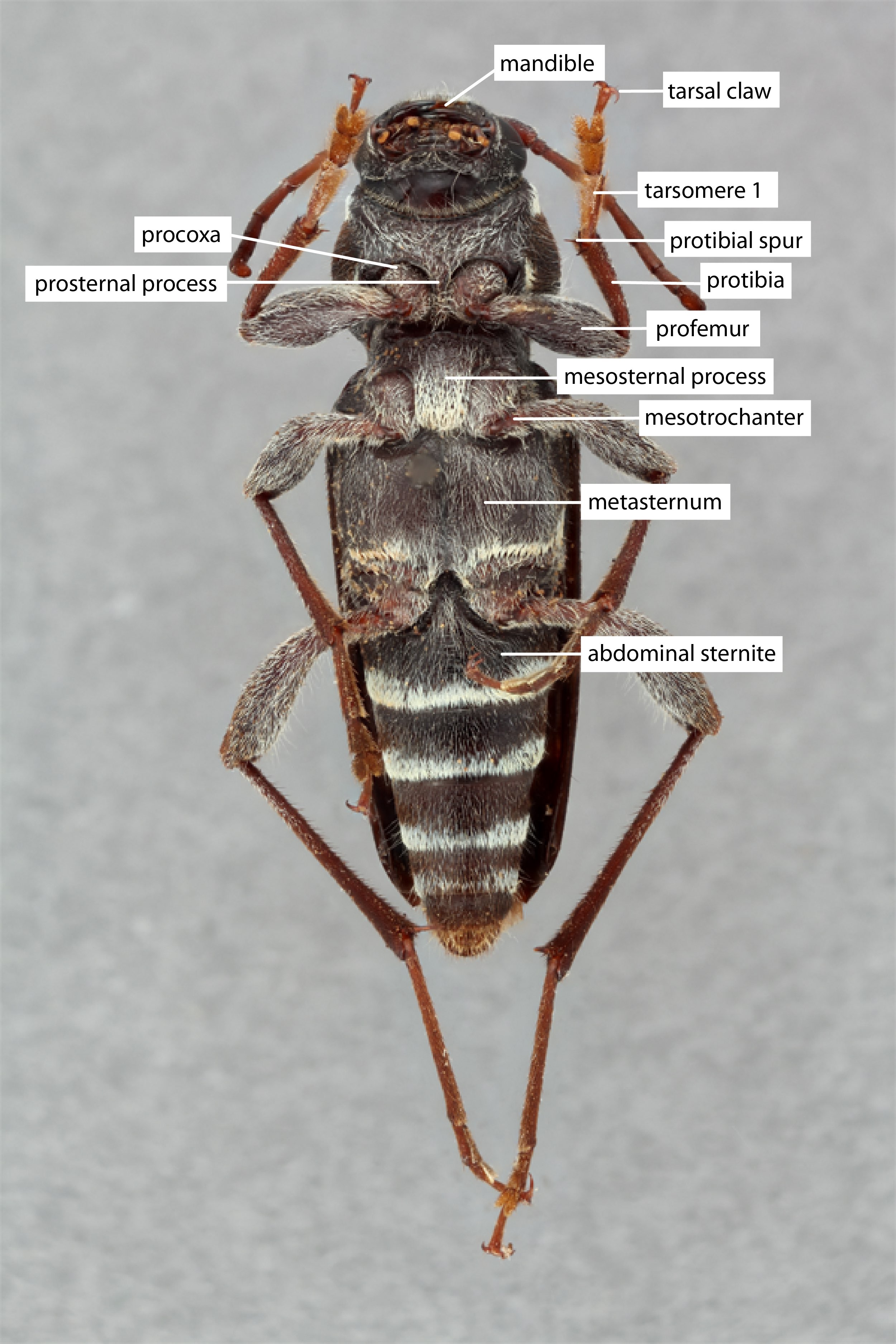 : 2, tarsal clawstarsal claw:
: 2, tarsal clawstarsal claw:
usually paired claws of the pretarsus, at the distal end of the leg simple.
simple.
Body large. Antennaeantenna:
in larval and adult insects, paired segmented appendages, borne one on each side of the head, functioning as sense organs and bearing a large number of sensilla
longer (male) or shorter (female) than body, thin markedly toward apexapex:
end of any structure distad to the base
. Pronotumpronotum:
the upper and dorsal part of the prothorax
transversely coarsely rugoserugose:
wrinkled
, rounded laterally, narrows more anteriorly, less posteriorly. Elytraelytron:
the leathery forewing of beetles, serving as a covering for the hind wings, commonly meeting opposite elytron in a straight line down the middle of the dorsum in repose
elongate, smooth, narrowly rounded apically and there, on side of suturesuture:
groove marking the line of fusion of two formerly distinct plates; the line of junction of elytra
, with acutely produced small spinulespinule:
a small spine
(Cherepanov 1988bCherepanov 1988b:
Cherepanov AI. 1988b. Cerambycidae of Northern Asia, Vol. 2. Cerambycinae Part I. Oxonian Press, New Delhi 2(1): i–xiii + 1–292, 133 figs.).
Hemadius, Massicus, Cerambyx
The very large body size, smooth elytraelytron:
the leathery forewing of beetles, serving as a covering for the hind wings, commonly meeting opposite elytron in a straight line down the middle of the dorsum in repose
, transversely rugoserugose:
wrinkled
pronotum with no lateral spines, and males with inflated antennomeresantennomere:
a subunit of the antenna, including the scape, pedicel, and flagellomeres
3–5 distinguish Neocerambyx.
Palearctic (Asia), Indomalaya
broadleaf trees
24 species and another ssp.
Pachydissus (Mallambyx) Bates, 1873
Mesocerambyx Itzinger, 1943
Bulbocerambyx Lazarev, 2019
Neocerambyx Thomson, 1861